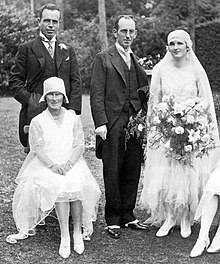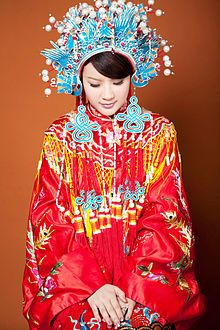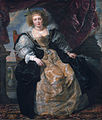Umbrella Hat Fashion White Long Sleeve Mermaid Dress

A wedding wearing apparel or conjugal gown is the clothes worn by the helpmate during a wedding ceremony. The color, style and ceremonial importance of the gown tin can depend on the religion and civilization of the hymeneals participants. In Western cultures and Anglo-Saxon cultural spheres, the wedding apparel is most commonly white, a fashion made popular past Queen Victoria when she married in 1840. In Eastern cultures, brides oft choose reddish to symbolize auspiciousness.
Western civilization [edit]

The woman on the right is wearing a typical wedding ceremony dress from 1929. Until the late 1960s wedding dresses reflected the styles of the day; since then they take often been based on Victorian styles.
Weddings performed during and immediately following the Heart Ages were often more than just a union between two people. They could be a union between two families, two businesses or even two countries. Many weddings were more than a affair of politics than love, especially amongst the nobility and the college social classes. Brides were therefore expected to dress in a manner that cast their families in the nigh favorable lite and befitted their social status, for they were not representing only themselves during the anniversary. Brides from wealthy families often wore rich colors and exclusive fabrics. It was mutual to see them wearing bold colors and layers of furs, velvet and silk. Brides dressed in the tiptop of current mode, with the richest materials their families' money could buy. The poorest of brides wore their all-time church building dress on their wedding day. The amount and the toll of material a hymeneals dress contained was a reflection of the helpmate's social standing and indicated the extent of the family's wealth to wedding guests.
Color of nuptials dresses [edit]
The get-go documented instance of a princess who wore a white wedding dress for a royal wedding ceremony is that of Philippa of England, who wore a tunic with a cloak in white silk bordered with squirrel and ermine in 1406, when she married Eric of Pomerania.[1] [2] Mary, Queen of Scots, wore a white wedding apparel in 1559 when she married her first husband, Francis, the Dauphin of France, because it was her favorite colour, although white was then the color of mourning for French queens.[3] [iv]
This was not a widespread trend, even so: prior to the Victorian era, a bride was married in whatever color, blackness being peculiarly pop in Scandinavia.[5]
White became a popular option in 1840, after the marriage of Queen Victoria to Albert of Saxe-Coburg and Gotha, when Victoria wore a white gown trimmed with Honiton lace. Illustrations of the wedding were widely published, and many brides opted for white in accordance with the Queen's pick.[6]
Later, many people causeless that the color white was intended to symbolize virginity, though this was not the original intention: it was the color bluish that was connected to purity, piety, faithfulness, and the Virgin Mary.[7]
Fifty-fifty after white became the dominant color, for a flow, wedding dresses were adapted to the styles of the day. In the early 1900s, clothing included a lot of decorations, such as lace or frills. This was also adopted in wedding dresses, where decorative frills and lace was common. For case, in the 1920s, they were typically short in the front end with a longer train in the back and were worn with cloche-style wedding ceremony veils. This trend to follow current fashions continued until the late 1960s, when it became popular to revert to long, full-skirted designs reminiscent of the Victorian era.
Since the middle of the 20th century, most Western wedding dresses are commonly white,[8] though "hymeneals white" includes shades such as eggshell, ecru and ivory.
White is non the universal color of wedding dresses. In Mexico, for instance, red is a popular color.[ citation needed ]
In The Church of Jesus Christ of Latter-day Saints the color white is used as a symbol of purity, innocence, and cleanliness, particularly in religious ceremonies such as baptism[9] and temple ceremonies, including weddings.[ten] For weddings in the temple, white clothing is as well worn past all participants during the ceremony, both men and women, to also symbolize unity and equality before God.[11] [12] The bride's should be "white, modest in design and cloth, and free of elaborate ornamentation."[13]
Current manner [edit]

A helpmate in a contemporary version of the traditional long white wedding dress with train, tiara and white veil.
In the early 21st century, almost 75% of wedding dresses on the market are sleeveless and strapless.[fourteen] Other brides prefer more pocket-size styles with sleeves, higher necklines, and covered backs. Near of today's wedding ceremony dresses have either lace-up backs or zipper backs. Wedding ceremony dresses can also exist long or brusk, depending on the type of nuptials.
Like any other clothes, the style of a wedding dress depends on not just the fabric, just the overall shape and features. Some of the most popular gimmicky dress silhouettes include: A-line, ballgown, empire, mermaid, tea-length, and trumpet. Popular contemporary necklines types include: disproportionate, bateau, halter, gem, off-the-shoulder, portrait, scoop, sheer, square, strapless, sweetheart, and 5-neck. The neckline refers to the shape of the material at the peak of the wearing apparel as it falls on the neck and shoulders.
Eastern culture [edit]
Many wedding dresses in Prc, India (wedding sari), Islamic republic of pakistan (heavily embroidered shalwar qameez or lehngas) are cherry; the traditional color representing good luck and auspiciousness. Vietnam hymeneals dresses (in the traditional form of áo tấc the aboriginal Ao dai) were blue, dark blue.
Present, many women choose other colours also ruby-red. In modernistic mainland Chinese weddings, the bride may opt for Western dresses of whatsoever colour, and don a traditional costume for the wedding tea ceremony.

Qing dynasty styled traditional Chinese wedding apparel with phoenix crown (鳳冠) headpiece notwithstanding used in modernistic Taiwanese weddings.
In modern Taiwanese weddings, the helpmate generally picks red (following Chinese tradition) or white (more Western) silk for the hymeneals gown cloth, just most will wearable the cherry-red traditional garment for their formal wedding ceremony banquets. Traditionally, the begetter of the bride is responsible for the hymeneals feast hosted on the bride'southward side and the alcohol (specifically called "11-jiu," confusingly the same as what the wedding ceremony banquet itself is called) consumed during both banquets. While the wedding itself is often based on the couple's choices, the wedding banquets are a symbolic gesture of "thank you" and appreciation, to those that have raised the bride and groom (such as grandparents and uncles) and those who will go on to exist there to help the helpmate and groom in the future. Thus out of respect for the elders, wedding banquets are usually done formally and traditionally.
Red wedding saris are the traditional garment option for brides in Indian culture. Sari fabric is as well traditionally silk. Over time, colour options and fabric choices for Indian brides accept expanded. Today fabrics similar crepe, Georgette, charmeuse, and satin are used, and colors accept been expanded to include gilt, pinkish, orange, maroon, dark-brown, and xanthous as well. Indian brides in Western countries often wear the sari at the hymeneals ceremony and change into traditional Indian wear later on (lehnga, choli, etc.).
Traditionally, a Kurdish first-fourth dimension bride would wear a red clothes for her wedding to symbolize the Postcoital haemorrhage she volition experience when she loses her virginity while a Kurdish bride who used to exist married earlier would habiliment pink. Today, many Kurds associate blood-red wedding dresses with impoverished Kurdish rural order and it is no longer commonly worn.[15] [16] [17]

Japanese formal wedding dress still used today.
A Japanese wedding unremarkably involves a traditional pure white kimono for the formal ceremony, symbolizing purity and maidenhood. The bride may change into a red kimono for the events later on the anniversary for good luck.
The Javanese people of Indonesia wear a kebaya, a traditional kind of blouse, along with batik.
In the Philippines, variations of the Baro't saya adjusted to the white wedding tradition are considered to exist wedding attire for women, forth with the Barong Tagalog for men. Various tribes and Muslim Filipinos don other forms of traditional dress during their corresponding ceremonies.
Native American civilisation [edit]

The indigenous peoples of the Americas have varying traditions related to weddings and thus nuptials dresses. A Hopi bride traditionally had her garments woven past the groom and whatsoever men in the village who wished to participate. The garments consisted of a large belt, ii all-white wedding robes, a white wedding robe with red stripes at pinnacle and bottom, white buckskin leggings and moccasins, a cord for tying the hair, and a reed mat in which to wrap the outfit. This outfit also served as a shroud, since these garments would be necessary for the trip through the underworld.
A Pueblo helpmate wore a cotton fiber garment tied above the right shoulder, secured with a chugalug around the waist.
In the traditions of the Delaware, a bride wore a human knee-length skirt of deerskin and a band of wampum beads around her forehead. Except for fine chaplet or beat out necklaces, the body was blank from the waist up. If information technology was a winter wedding, she wore deerskin leggings and moccasins and a robe of turkey feathers. Her face was painted with white, crimson and yellowish clay.
The tribes of Northern California (which include the Klamath, the Modoc and the Yurok) had a traditional bridal dress woven in symbolic colors: white for the due east, blue for the southward, yellowish (orange) for the w; and black for the north. Turquoise and silvery jewelry were worn by both the bride and the groom in addition to a silver concho chugalug. Jewelry was considered a shield against evils including hunger, poverty and bad luck.
Gallery [edit]
Historical European wedding dresses [edit]
-

Helena Fourment, second wife of Peter Paul Rubens, painted past Rubens in her nuptials apparel, 1630.
-

-

Wedding dresses from different areas of the globe [edit]
-

Traditional Japanese wedding robes worn by the Crown Prince of Nippon, Akihito and Michiko Shoda for their marriage, 1959.
-

Wishram (Due north American Indian) bride effectually 1911
-

Traditional Finnish farmer wedding dress in Jomala, Åland
-

Traditional Kazakh wedding dress
-

-

Due west Asian/North African dresses [edit]
East Asian dresses [edit]
-

Chinese couple wearing traditional nuptials hanfu
-
Reenactment of the regal nuptials anniversary of Rex Gojong and Queen Myeongseong
South Asian dresses [edit]
-

-

Indian Christian bride in white Sari
-

Nepali bride of Kathmandu, 1941
-

-

-

Marathi Wedding
-

Sri Lankan Wedding ceremony
Southeast Asian dresses [edit]
-
Khmer (Cambodian) couple dressed in traditional wedding outfits
-

Vietnamese couple in traditional dress
-

Couple dress in traditional Thai outfits
-

Couple dressed in traditional Burmese outfits
-

Bali Hindu Wedding Dress
Modern Western-fashion dresses [edit]
-

A bride in 1968, wearing a dress reflecting the styles of the time
-

-

Taiwanese couple dressed Western-way for keepsake photos in the park, 1989
-

American bride marrying a Scotsman wearing a kilt, 1996
-

New Orleans helpmate wearing a strapless, sleeveless gown, 2006
See also [edit]
- Christian wear
- Godey's Lady's Book
- Religious clothing
- Victorian fashion
- Hymeneals dress of Camilla Parker Bowles
- Nuptials dress of Grace Kelly
- Wedding apparel of Jacqueline Bouvier
- Nuptials wearing apparel of Kate Middleton
- Wedding dress of Lady Diana Spencer
- Nuptials dress of Meghan Markle
- Nuptials dress of Princess Alexandra of Denmark
- Hymeneals wearing apparel of Princess Anne
- Hymeneals apparel of Princess Elizabeth
- Wedding ceremony dress of Princess Margaret
- Wedding dress of Princess Mary of Teck
- Wedding clothes of Queen Victoria
- Wedding dress of Sarah Ferguson
- Hymeneals dress of Sophie Rhys-Jones
- Nuptials apparel of Victoria, Princess Royal
- Wedding dress of Wallis Warfield
References [edit]
- ^ "Wedding white doesn't mean what you recall it ways". Ivy Conjugal Studio. three March 2014. Archived from the original on eleven May 2016. Retrieved 21 Nov 2014.
Princess Philippa of England is the commencement recorded princess to take worn white during her wedding in 1406, with her attire consisting of a tunic and cloak in white silk, simply it wasn't until Queen Mary that the white dress would explode in popularity
- ^ "The History of Marriage". Amalfi Wedding Planner. Archived from the original on half dozen May 2006.
- ^ "Mary, Queen of Scots' offset wedding 24-hour interval". Madame Guillotine. 24 April 2011. Archived from the original on 23 June 2015. Retrieved 21 November 2014.
Mary'south pick of a white wedding clothes was an unusual i, particularly as white was more traditionally worn by imperial ladies when they were in dieul blanc mourning simply in this as in other things the strong willed Mary may well take been an innovator, keen to not just impress her ain taste on her wedding day (after all, she hadn't been allowed the privilege of choosing her groom) but also emphasise her virginity and show off her famously stake redheaded dazzler, which would accept been accentuated by a pure white dress.
- ^ "Elizabeth I Facts". The Elizabeth Files. Archived from the original on 24 July 2018. Retrieved 21 November 2014.
Her favourite dress colours were white and black which symbolised purity.
- ^ Pelo, June. "Old Marriage Customs in Finland". Sydaby.eget.net . Retrieved nineteen January 2019.
- ^ "Royal Weddings 1840-1947". Royal Collection Trust . Retrieved xix January 2019.
- ^ Ashliman, DL (2004). Folk and Fairy Tales: A Handbook–Greenwood Sociology Handbooks. ABC-CLIO. p. 9. ISBN9780313058592.
- ^ Stewart, Jude (14 February 2011). "The Bride Wore Chartreuse: Why (Most) Nuptials Dresses are White". Print . Retrieved 19 Jan 2019.
- ^ "Affiliate 15: The Covenant of Baptism". Doctrines of the Gospel Teacher Manual. The Church of Jesus Christ of Latter-mean solar day Saints. Retrieved 16 December 2021.
- ^ "Preparing to Enter the Holy Temple". Preparing to Enter the Holy Temple. The Church of Jesus Christ of Latter-24-hour interval Saints. Retrieved 16 December 2021.
- ^ "Lesson v: Learning from the Lord through Symbols". Endowed from on Loftier: Temple Grooming Seminar Instructor's Transmission. The Church of Jesus Christ of Latter-day Saints. Retrieved 16 December 2021.
- ^ "Why Symbols?". Ensign. The Church of Jesus Christ of Latter-day Saints. February 2007. Retrieved 16 December 2021.
- ^ "27. Temple Ordinances for the Living". General Handbook: Serving in The Church of Jesus Christ of Latter-day Saints. The Church of Jesus Christ of Latter-twenty-four hour period Saints. Retrieved 20 September 2021.
- ^ Goldstein, Katherine (17 May 2012). "Say Yes to a Unlike Dress: Down with the strapless wedding gown". Slate . Retrieved 29 May 2012.
- ^ Allison, Christine (1996). Kurdish Culture and Identity. Bloomsbury Bookish. p. 154.
- ^ Russel, Jan (November 2007). They Lived to Tell the Tale. Lyons Press.
- ^ Smothers Bruni, Mary Ann (1995). Journey Through Kurdistan. Texas Memorial Museum. p. 57.
External links [edit]
- Mode Plates of Wedding Dresses from 1820-1929 from The Metropolitan Museum of Art Libraries
- Wedding Dresses at Chicago History Museum Digital Collections
- Hymeneals dress, 1900, in the Staten Isle Historical Society Online Collections Database
- Wedding dress, 1951, in the Staten Island Historical Social club Online Collections Database


0 Response to "Umbrella Hat Fashion White Long Sleeve Mermaid Dress"
Post a Comment